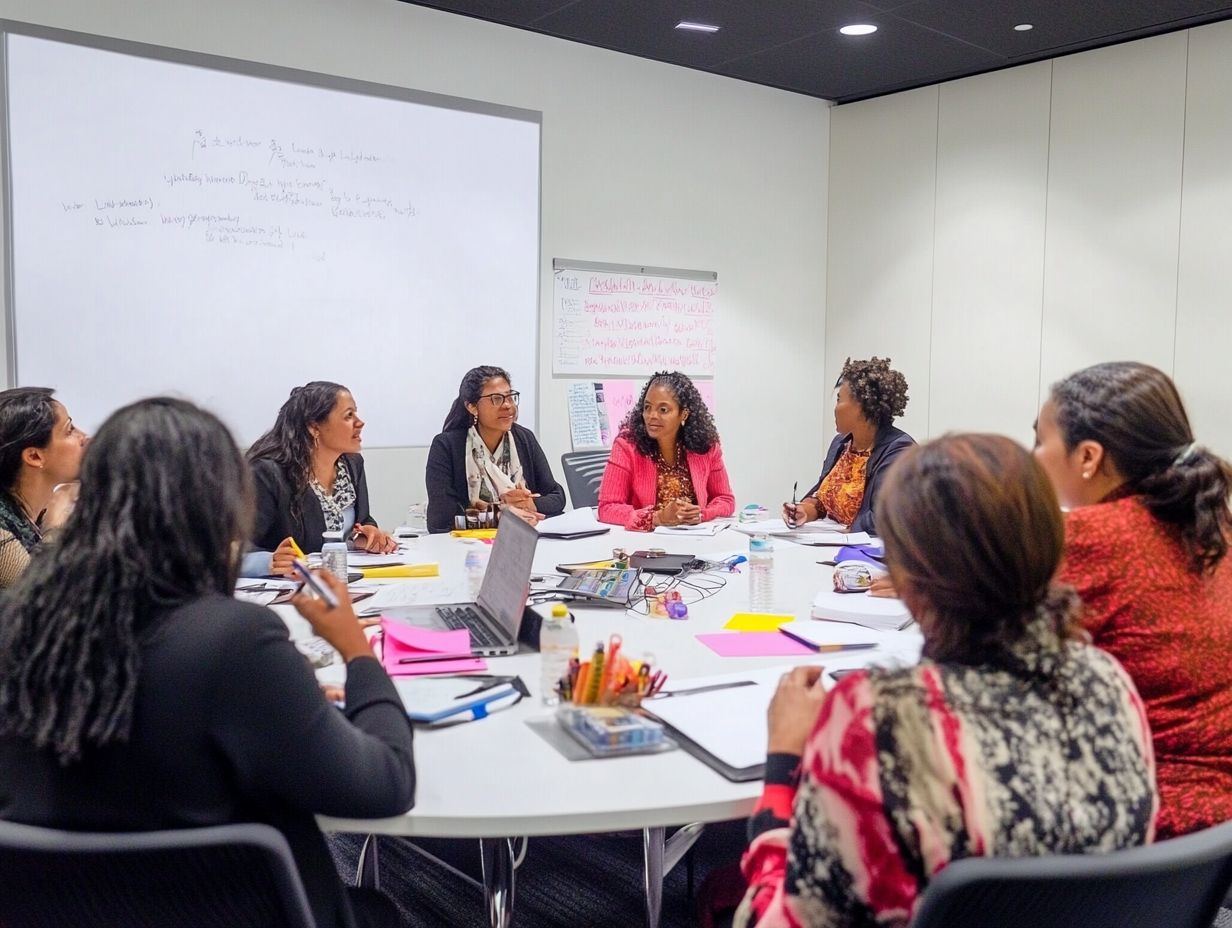Integrating Diversity in Leadership Training
Diversity in leadership transcends mere buzzwords; it serves as a crucial element that fuels innovation and cultivates a vibrant workplace culture.
As you work to establish inclusive environments, the benefits you reap extend far beyond business outcomes. They empower individuals at every level.
While implementing effective diversity training presents its own set of challenges, the rewards are well worth the effort.
This article delves into the significance of diversity in leadership, outlines the essential components of successful training, and offers strategies for weaving these principles into leadership development. Take action now to make a measurable impact on both your teams and overall organizational growth.
Contents
- Key Takeaways:
- The Importance of Diversity in Leadership
- Challenges in Diversity Training
- Key Components of Effective Diversity Training
- Integrating Diversity in Leadership Training
- Measuring the Success of Diversity Training
- Frequently Asked Questions
- What is the importance of integrating diversity in leadership training?
- How can diversity be incorporated into leadership training?
- What challenges may arise when integrating diversity in leadership training?
- How can leaders benefit from diversity in leadership training?
- In what ways can diversity in leadership training improve team dynamics and productivity?
- How can organizations ensure the successful integration of diversity in leadership training?
Key Takeaways:

- Diversity in leadership opens the door to fresh perspectives and innovative solutions.
- Challenges in diversity training, such as unconscious bias, can be overcome through inclusive and culturally competent strategies.
- Effective diversity training includes promoting equity, developing cultural competence, and addressing unconscious bias.
The Importance of Diversity in Leadership
The importance of diversity in leadership truly cannot be overstated. It serves as a cornerstone for cultivating an inclusive environment that propels organizational success. When you embrace diverse perspectives, you not only elevate your decision-making processes but also foster a workforce that represents a rich tapestry of cultural identities. This, in turn, enriches your company culture.
As you work towards implementing effective management strategies, the value of inclusive leadership becomes increasingly evident, particularly in today’s fast-paced business landscape.
Benefits for Organizations and Individuals
The benefits of diversity in leadership extend far beyond the confines of organizations; they profoundly impact you as an individual. This fosters high-performing employees who bring unique perspectives to the table.
A dynamic environment sparks creativity and enhances your engagement, as you and your colleagues feel valued and included. Through diverse collaborations, you develop greater emotional intelligence, equipping you to navigate complex social dynamics and forge stronger relationships.
Organizations that prioritize Diversity, Equity, and Inclusion (DEI) initiatives witness increased innovation and improved problem-solving capabilities. Varied viewpoints contribute to more comprehensive solutions. Such inclusive practices attract top talent, ensuring a rich pool of skills and experiences that drive overall success.
By embracing diversity, you cultivate an atmosphere where both individuals and organizations can truly thrive.
Challenges in Diversity Training
Despite the undeniable significance of diversity training in cultivating inclusive leadership, you may encounter several challenges that can impede its effectiveness.
These obstacles often arise during the process of behavior change and conflict resolution, complicating your path to fostering a truly inclusive environment.
Common Obstacles and How to Overcome Them
Common obstacles in diversity training often arise from microaggressions and unconscious biases that can significantly undermine its effectiveness.
These subtle behaviors can make you feel uncomfortable or defensive, hindering the open dialogue essential for meaningful growth. Many individuals carry preconceived notions that can influence their receptiveness to new ideas and perspectives.
To counteract these challenges, organizations should implement strategies such as:
- Facilitated discussions
- Role-playing exercises
- Ongoing support mechanisms
By fostering a culture of empathy and active listening, organizations can create safe spaces for honest conversations. This approach ultimately enables you to challenge your assumptions and biases, leading to more impactful learning outcomes.
Key Components of Effective Diversity Training

Key components of effective diversity training programs encompass a focus on inclusion and equity, the development of cultural competency, and a robust organizational commitment to diversity initiatives.
By prioritizing these elements, you can create an environment that not only values diversity but actively promotes it throughout the organization.
Inclusion and Equity
Inclusion and equity serve as the cornerstones of an effective diversity training program. They directly impact workplace equity and shape the overall organizational culture.
When you weave these principles into your initiatives, you create an environment where everyone feels valued and enabled to contribute. This sense of belonging boosts morale and enhances collaboration among team members, unlocking increased innovation and problem-solving potential.
By prioritizing inclusion and equity in your diversity efforts, you foster a more harmonious and productive atmosphere. This approach attracts a diverse range of talent and nurtures a dynamic organizational culture where diverse perspectives are celebrated. Every individual plays a crucial role in driving collective success.
Cultural Competency
Cultural competency is vital for you as a leader. It enhances your cultural awareness and significantly influences team interactions within your diverse workforce.
By understanding and respecting different cultures, you can help team members understand each other better and foster an inclusive environment where every voice is valued.
This skill promotes mutual respect and encourages collaboration, sparking innovation. When managed effectively, diverse teams bring together a rich tapestry of perspectives that fuel creativity and enhance problem-solving.
Prioritizing cultural competency helps you navigate challenges adeptly. You build stronger relationships among your staff and elevate team performance by cultivating a climate of trust and empathy.
Unconscious Bias Awareness
Increasing your awareness of unconscious biases is essential for driving meaningful behavior change. It helps integrate emotional intelligence into your leadership style.
By deepening your understanding of these hidden prejudices, you can foster an inclusive environment where diverse perspectives are genuinely valued.
This awareness enhances your interpersonal relationships and enables you to make more informed and empathetic decisions.
As you engage with your own biases and recognize their impact on team dynamics, you set the stage for transformative changes in workplace culture. You become more adept at leveraging emotional intelligence, facilitating open dialogue, and encouraging collaboration among diverse teams.
This shift leads to improved organizational performance and sparks innovation across the board.
Integrating Diversity in Leadership Training
Act now to integrate diversity into leadership training. This essential approach, highlighted in the role of diversity in leadership perspectives, will cultivate the leaders of tomorrow.
By prioritizing diversity, you create an environment where varied perspectives thrive, ultimately shaping more effective and innovative leaders.
Strategies for Incorporating Diversity in Leadership Training

Implementing strategies for incorporating diversity in leadership training includes action learning projects, networking programs, and establishing performance metrics to track progress.
These approaches cultivate an inclusive environment and enhance problem-solving and innovation within teams. Action learning projects are projects where participants learn by working on real challenges, fostering collaboration among diverse groups and promoting shared perspectives.
Networking programs offer a valuable platform for underrepresented individuals to connect with mentors and industry leaders. This effectively bridges gaps and creates a more equitable landscape.
Establishing performance metrics boosts accountability and keeps your diversity efforts on track! This helps measure the effectiveness of diversity initiatives while continuously refining your leadership training methods.
Emphasizing these methodologies ensures a comprehensive strategy that nurtures diverse talents and fosters inclusive leadership practices.
Measuring the Success of Diversity Training
Measuring the success of diversity training requires the use of comprehensive metrics and evaluation methods. This assessment is crucial for understanding its long-term impact and ensuring alignment with your organization s commitment to diversity and inclusion.
Metrics and Evaluation Methods
To measure the effectiveness of your diversity training programs, consider utilizing a blend of performance metrics and employee feedback.
To truly gauge the impact of these initiatives, incorporate a variety of measurable data, such as pre- and post-training assessments that evaluate knowledge retention and behavioral shifts. Monitoring participation rates in follow-up sessions can offer valuable insights into engagement and commitment levels.
Conducting surveys that assess workplace inclusivity and employee satisfaction especially among underrepresented groups can yield critical insights into the training’s effectiveness.
Combining qualitative data from focus groups with quantitative statistics creates a more comprehensive understanding of the program’s influence on workplace culture and facilitates ongoing improvement efforts.
Frequently Asked Questions
What is the importance of integrating diversity in leadership training?
Integrating diversity in leadership training fosters a more inclusive and representative environment where everyone can thrive. It also helps eliminate bias and promotes understanding and collaboration among team members.
How can diversity be incorporated into leadership training?

Diversity can be incorporated into leadership training through various methods. This includes including diverse perspectives and examples in training materials, providing opportunities for participants to share their experiences, and promoting diversity in leadership roles.
What challenges may arise when integrating diversity in leadership training?
Challenges include resistance to change and lack of resources or support. Addressing these challenges through open communication is crucial for successful integration.
How can leaders benefit from diversity in leadership training?
Leaders can gain a better understanding of diverse perspectives and experiences. This helps develop more inclusive leadership styles and create diverse, innovative teams.
Diversity in leadership training also enhances decision-making and problem-solving in an increasingly diverse world.
In what ways can diversity in leadership training improve team dynamics and productivity?
Diversity in leadership training boosts team dynamics and productivity. It promotes creativity, innovation, and respect for various perspectives.
How can organizations ensure the successful integration of diversity in leadership training?
To integrate diversity in leadership training successfully, organizations should provide resources and support. They must encourage everyone to feel welcome and set clear goals while regularly updating their training methods.
Take action now to enhance your team’s performance!






